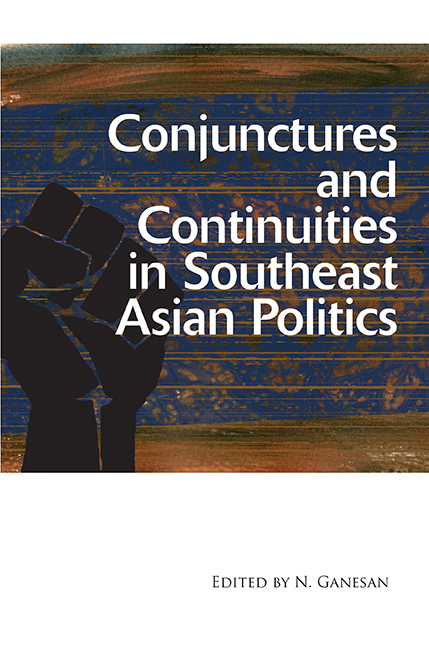Book contents
- Frontmatter
- Contents
- Acknowledgements
- List of Abbreviations
- Contributors
- 1 Conjunctures and Continuities in Southeast Asian Politics
- 2 (Re)Assessing the EDSA “People Power” (1986) as a Critical Conjuncture
- 3 The Road to Doi Moi in 1986: Domestic Dimensions
- 4 The 1988 Uprising in Myanmar: Historical Conjuncture or Praetorian Redux?
- 5 Cambodia's Historical Conjunctures and their Significance
- 6 Changing the Rules: Historical Conjuncture and Transition in Indonesia
- 7 The Resistible Rise of Thaksin Shinawatra: Crisis, Change and the Collapse of Thailand's Democracy
- 8 The March 2008 General Election in Malaysia as a Historical Conjuncture
- 9 Conclusion: Conjunctures and Continuities in Southeast Asia
- Index
6 - Changing the Rules: Historical Conjuncture and Transition in Indonesia
Published online by Cambridge University Press: 21 October 2015
- Frontmatter
- Contents
- Acknowledgements
- List of Abbreviations
- Contributors
- 1 Conjunctures and Continuities in Southeast Asian Politics
- 2 (Re)Assessing the EDSA “People Power” (1986) as a Critical Conjuncture
- 3 The Road to Doi Moi in 1986: Domestic Dimensions
- 4 The 1988 Uprising in Myanmar: Historical Conjuncture or Praetorian Redux?
- 5 Cambodia's Historical Conjunctures and their Significance
- 6 Changing the Rules: Historical Conjuncture and Transition in Indonesia
- 7 The Resistible Rise of Thaksin Shinawatra: Crisis, Change and the Collapse of Thailand's Democracy
- 8 The March 2008 General Election in Malaysia as a Historical Conjuncture
- 9 Conclusion: Conjunctures and Continuities in Southeast Asia
- Index
Summary
In 1998 Indonesia faced the political consequences of economic turmoil and decades of repression. The Asian financial crisis had triggered reformasi, but it was arguably the oppression of the New Order regime, thirty-three years of increasingly centralized authoritarian rule, that fuelled the anger and passions of so many Indonesians. By May of the same year, student demonstrators were openly calling for President Soeharto to step down, an act unimaginable a few months prior. There was an increase in ethnic violence and communal riots, not only in Jakarta, but throughout the archipelago. And as if to punctuate matters, forest fires raged on the resource-rich island of Kalimantan, covering much of the region with smog. At the time, observers of Indonesia expressed pessimism about the country's future prospects.
A decade on, Indonesia has experienced a remarkable recovery. It is currently the leading democracy in Southeast Asia, some might say, the only democracy in the region. Much of the ethnic and religious conflict that flared up in the waning days of the New Order and the political transition has tapered off. The economy has undergone an impressive revival. To be sure, many problems remain, including corruption, elite entrenchment and the spectre of violent Islamic fundamentalism. But a decade ago, few would have predicted Indonesia would be as politically and economically successful as it is today.
How did such a period of uncertainty and turmoil result in a seemingly stable and successful political regime? One reason for Indonesia's success today may be rooted in the historical moment of political transition sandwiched between these two periods. The resignation of Soeharto and the transition thereafter symbolized a massive rupture in Indonesian political development and began the process of building an entirely different kind of regime. Scholars call moments such as these historical conjunctures or critical junctures. Among the major reforms were democratization and far-reaching decentralization. The decision to implement these reforms and the particular way this was done, I argue, helps to account for the outcomes we see today.
- Type
- Chapter
- Information
- Conjunctures and Continuities in Southeast Asian Politics , pp. 123 - 150Publisher: ISEAS–Yusof Ishak InstitutePrint publication year: 2013



